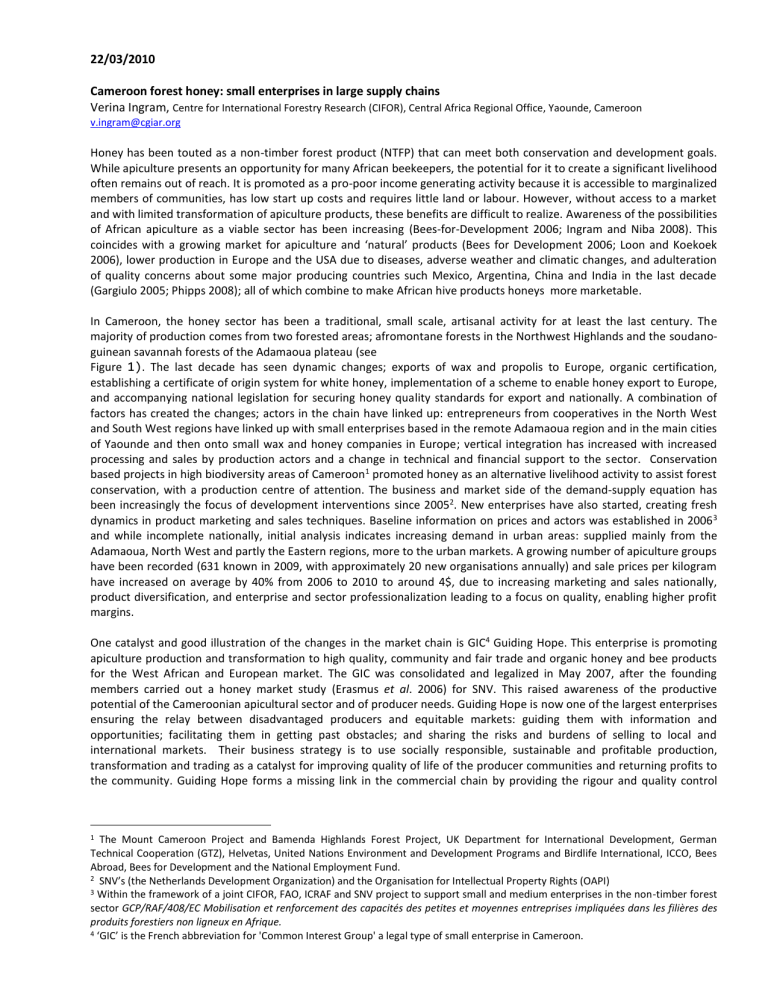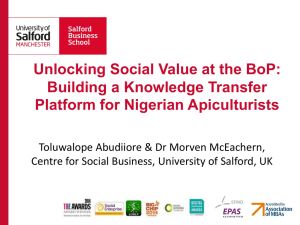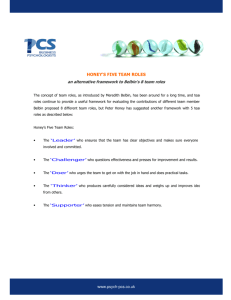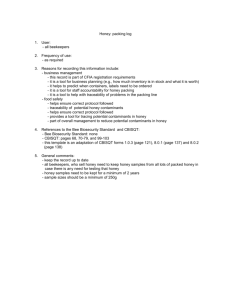22/03/2010 Cameroon forest honey: small enterprises in large supply chains Verina Ingram,

22/03/2010
Cameroon forest honey: small enterprises in large supply chains
Verina Ingram,
Centre for International Forestry Research (CIFOR), Central Africa Regional Office, Yaounde, Cameroon v.ingram@cgiar.org
Honey has been touted as a non-timber forest product (NTFP) that can meet both conservation and development goals.
While apiculture presents an opportunity for many African beekeepers, the potential for it to create a significant livelihood often remains out of reach. It is promoted as a pro-poor income generating activity because it is accessible to marginalized members of communities, has low start up costs and requires little land or labour. However, without access to a market and with limited transformation of apiculture products, these benefits are difficult to realize. Awareness of the possibilities of African apiculture as a viable sector has been increasing (Bees-for-Development 2006; Ingram and Niba 2008). This coincides with a growing market for apiculture and ‘natural’ products (Bees for Development 2006; Loon and Koekoek
2006), lower production in Europe and the USA due to diseases, adverse weather and climatic changes, and adulteration of quality concerns about some major producing countries such Mexico, Argentina, China and India in the last decade
(Gargiulo 2005; Phipps 2008); all of which combine to make African hive products honeys more marketable.
In Cameroon, the honey sector has been a traditional, small scale, artisanal activity for at least the last century. The majority of production comes from two forested areas; afromontane forests in the Northwest Highlands and the soudano-
guinean savannah forests of the Adamaoua plateau (see
. The last decade has seen dynamic changes; exports of wax and propolis to Europe, organic certification, establishing a certificate of origin system for white honey, implementation of a scheme to enable honey export to Europe, and accompanying national legislation for securing honey quality standards for export and nationally. A combination of factors has created the changes; actors in the chain have linked up: entrepreneurs from cooperatives in the North West and South West regions have linked up with small enterprises based in the remote Adamaoua region and in the main cities of Yaounde and then onto small wax and honey companies in Europe; vertical integration has increased with increased processing and sales by production actors and a change in technical and financial support to the sector. Conservation based projects in high biodiversity areas of Cameroon 1 promoted honey as an alternative livelihood activity to assist forest conservation, with a production centre of attention. The business and market side of the demand-supply equation has been increasingly the focus of development interventions since 2005 2 . New enterprises have also started, creating fresh dynamics in product marketing and sales techniques. Baseline information on prices and actors was established in 2006 3 and while incomplete nationally, initial analysis indicates increasing demand in urban areas: supplied mainly from the
Adamaoua, North West and partly the Eastern regions, more to the urban markets. A growing number of apiculture groups have been recorded (631 known in 2009, with approximately 20 new organisations annually) and sale prices per kilogram have increased on average by 40% from 2006 to 2010 to around 4$, due to increasing marketing and sales nationally, product diversification, and enterprise and sector professionalization leading to a focus on quality, enabling higher profit margins.
One catalyst and good illustration of the changes in the market chain is GIC 4 Guiding Hope. This enterprise is promoting apiculture production and transformation to high quality, community and fair trade and organic honey and bee products for the West African and European market. The GIC was consolidated and legalized in May 2007, after the founding members carried out a honey market study (Erasmus et al. 2006) for SNV. This raised awareness of the productive potential of the Cameroonian apicultural sector and of producer needs. Guiding Hope is now one of the largest enterprises ensuring the relay between disadvantaged producers and equitable markets: guiding them with information and opportunities; facilitating them in getting past obstacles; and sharing the risks and burdens of selling to local and international markets. Their business strategy is to use socially responsible, sustainable and profitable production, transformation and trading as a catalyst for improving quality of life of the producer communities and returning profits to the community. Guiding Hope forms a missing link in the commercial chain by providing the rigour and quality control
1 The Mount Cameroon Project and Bamenda Highlands Forest Project, UK Department for International Development, German
Technical Cooperation (GTZ), Helvetas, United Nations Environment and Development Programs and Birdlife International, ICCO, Bees
Abroad, Bees for Development and the National Employment Fund.
2 SNV’s (the Netherlands Development Organization) and the Organisation for Intellectual Property Rights (OAPI)
3 Within the framework of a joint CIFOR, FAO, ICRAF and SNV project to support small and medium enterprises in the non-timber forest sector GCP/RAF/408/EC Mobilisation et renforcement des capacités des petites et moyennes entreprises impliquées dans les filières des produits forestiers non ligneux en Afrique.
4 ‘GIC’ is the French abbreviation for 'Common Interest Group' a legal type of small enterprise in Cameroon.
necessary to access international high value markets and develop new products. This market value chain approach links four main groups:
1.
755 beekeepers who supply raw honey, comb and propolis ). The majority are poor, rural farming men (average annual income 850 US$ in 2007) based in six villages around Ngaoundal, in Adamaoua, a transition zone between the tropical south and the soudano-sahelian north and the biggest honey production area in Cameroon.
Beekeeping contributes to 48% of their total income, which varies widely seasonally and annually due to annual production variances, and limited capacity to manage sales to benefit from price fluctuations (Soukontoua et al.
2007). Beekeepers have been trained to shift from rudimentary wax production techniques to lower wood inputs, larger scale and cleaner methods to produce certified organic, ‘yellow’ wax that is sold at up to 50% higher price than the traditional dark, smoky wax. As only 5 of the 7 bee-farmers groups are well organised and legally registered, part of Guiding Hope’s social community development philosophy is to assist them to group, legalise and empower them with training in technical aspects of production and in organisational aspects such as quality control, administration and accounting and community development based on their needs. Training on local transformation into high demand products such as soap, creams and candles means these can be auto-consumed or sold locally. Once sufficient quality and experience has been gained in this artisanal production, Guiding Hope aims to incorporate these new products into its honey trading network in major cities in Cameroon and potentially, for export.
The North West region is the second major area in Cameroon, with around 8,200 beekeepers and traders active, organized into at least 66 groups and four main unions. One of these, Oku Honey Cooperative, has some 200 members in the largest montane forest remnant in highlands. The majority are married, middle aged males with over 55% having at least primary level education and 18% secondary schooling. No one ethnic group predominates as beekeepers. Income from beekeeping contributes between 10 to 70% of total income, with the average contribution 30%. 51% of beekeepers in Oku name apiculture as their primary activity, with an average annual income from apiculture of $587 in 2007, calculating for all associated costs, profit is estimated at an average of $62.
2.
The second partnership is with a development partner in Cameroon, Programme d’Appui aux Initiatives Locales à
L’Auto-Emploi (PAELLA-E), who is paid from profits to provide the technical assistance to meet standards and legislation for export and certification set in Europe and the USA, and grass roots delivery of training and development support to producer communities.
3.
A third partner, a small honey and wax importer and trader in the UK, Tropical Forest Products, offers one route for exports particularly to the UK. A long term trading partnership has been negotiated to formalise the trading partnership. Their expertise gained in the comparable Zambian honey sector has allowed Guiding Hope to enter the European export market and the high value certified organic, ethical and community trade markets for honey and wax. This niche market is essential given the relatively small production scale compared to major producing countries such as India, China and Argentina and offers a way to export competitive high value apiculture products profitably.
4.
Guiding Hope itself also processes and sells to the national market, mainly filtered savannah and white highlands honey. Recently it started piloting production of a range of added value products such as creams, soaps, candles based on wax, honey and propolis. It also exports wax and propolis to other buyers in Europe. Investment in a range of analyses of its products has been used to demonstrate the organic nature and general characteristics of their products and profile them as pure, natural and high quality.
Despite beekeeping’s positive image, environmental sustainability of the sector is a real issue, which in turn affects economic long term viability. A positive aspect of apiculture is that bees are vital for agriculture, being the one of the major pollinators of the local staple crops and important fruits such as mangoes and avocados (Aizen et al. 2008), as well as being critical in pollinating forest trees. Adamaoua contains a range of ecosystems: flood plains and marshlands, gallery forests - where hive materials are found, and savannah - the main forage for bees. The savannah forest is dominated by two species: Daniella oliveri and Lophira lanceolata, both important nectar and pollen sources. However, their wood is also prized for fuel, as wood constitutes the major energy source in the region, for domestic cooking, fish smoking and for melting honey combs to extract wax. Agro-pastoral conflicts are common. Whilst beekeeping doesn’t require a set portion of land since hives are placed across the forest high in trees, the main threat from pastoralists is burning to stimulate new grass growth and remove cattle pests. Despite soils being generally fairly rich in minerals, fertility is gradually decreasing with repeated burning. Widespread hunting has reduced the wild animal population, possibly resulting in population explosions of some pests to bees, notably the African palm civet. Unmanaged deforestation is contributing to soil erosion and desertification, with serious degradation mainly along roads to urban areas. The Cameroon Action Plan for the Fight against Desertification 2007 designated Adamaoua a priority zone, noting that signs of desertification are gradually appearing but are not yet serious due to the low population density (average 8 inhabitants per sq km, national average is
29) and the region is relatively humid. The local population is however increasing exponentially and is expected to
continue to do so. To counteract these problems and secure sufficient bee forage, a number of village replanting and forest protection based on customary, traditional rulers and mechanisms has been initiated. In Oku, forest loss is even more significant despite the presence of community forests (Nurse, McKay et al. 1995) which slowed down the rate of forest loss from 50% between 1958 and 1988 (Kew 2003), but which has increased in the last decade to an estimated 62% of area between 1988 and 2001.
The amalgamation of high value export markets, expanding national markets, a new focus on quality and marketing, adding value by locally processing hive products into a range of products for the local market, and export markets both regionally and internationally, plus the attention to ensuring growth in production and sustainability, sets a positive scene for the development of the sector. Small and medium enterprise and organisations are driving this, providing a positive model for small scale forest based business.
Figure 1 Major honey production areas of Cameroon
References
Aizen, M. A., L. A. Garibaldi, S. A. Cunningham and A. M. Klein (2008). "Long-Term Global Trends in Crop Yield and
Production Reveal No Current Pollination Shortage but Increasing Pollinator Dependency." Current Biology
10(16).
Bees-for-Development (2006). Observer Presentation:The African Honey Trade: Unlocking the Potential. UNCTAD Expert
Meeting; Enabling small commodity producers in developing countries to reach global markets, UNCTAD
Commodities Branch.
Bees for Development (2006). Observer Presentation:The African Honey Trade: Unlocking the Potential. UNCTAD Expert
Meeting; Enabling small commodity producers in developing countries to reach global markets, UNCTAD
Commodities Branch.
Erasmus, T., D. Hamaljoulde, J. Samaki, M. T. Njikeu and G. M. Nyat (2006). Highlands Honey and Bee Products Market
Study. Bamenda, Netherlands Development Organisation (SNV), Highlands 61.
Gargiulo, G. (2005). Food safety capacity-building needs: the Argentine food industry. Industrial Development Report 2005
Background Paper Series. UNIDO: 30.
Ingram, V. and F. J. Niba (2008). More money from honey by-products……, SNV- Netherlands Development Organisation: 2.
Kew, R. B. G. (2003). "Western Cameroon Projects: Monitoring vegetation cover changes in Mount Oku and the Ijim Ridge
(Cameroon) using satellite and aerial sensor detection." Retrieved 21 December 2009, 2009, from http://www.kew.org/gis/projects/oku_cameroon/index.html
.
Loon, M. v. and F. J. Koekoek (2006). Export Opportunities for African Organic Honey and Beeswax A survey of the markets in Germany, the United Kingdom, and the Netherlands. EPOPA. Bennekom, Netherlands, EPOPA: 48.
Nurse, M. C., C. R. McKay, J. T. Young and C. A. Asanga (1995). "BIODIVERSITY CONSERVATION THROUGH COMMUNITY
FORESTRY, IN THE MONTANE FORESTS OF CAMEROON." RDFN Paper 18d.
Phipps, R. P. (2008). HONEY MARKET REPORT, American Honey Producers Association: 5.
Soukontoua, Y., E. Mfomou and R. Howard (2007). Report of the Socio-Economic Study Based on Beekeeping in Adamoua.
P.-E. CAMEROUN. Ngoundal, PAELLA-E CAMEROUN: 31.



